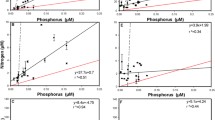Abstract
The environmental conditions in laminated microbial sediment ecosystems on the island of Schiermonnikoog (The Netherlands) were monitoredin situ over 24-hour periods by using micro-electrodes. In the layer of purple sulfur bacteria dramatic diel aerobic/anaerobic shifts occurred, whereas the top layer of cyanobacteria was occasionally confronted with sulfide. Pure cultures of the dominant organisms, being the cyanobacteriumMicrocoleus chthonoplastes and the purple sulfur bacteriumThiocapsa roseopersicina, were subjected to regimes mimicking the natural circumstances. It was demonstrated that both organisms are physiologically very well adapted to the fluctuating environmental conditions. The organisms interact by releasing metabolic end-products, the removal of toxic compounds and by competition for common substrates. It was demonstrated that positive interactions between both organisms are more important than negative interactions.
Similar content being viewed by others
References
BAAS BECKING, L.G.M., 1925. Studies on the sulphur bacteria. Ann, Bot., 39: 613–650.
BAULD, J., 1984. Mierobial mats in marginal marine environments: Shark Bay, Western Australia, and Spencer Gulf, South Australia. In: Y. Cohen, R.W. Castenhoiz, and H.O. Halvorson, Eds.), Microbial Mats: Stromatolites. Liss, New York; pp. 39–58.
BEEFTINK, H.H. and H. VAN GEMERDEN, 1979. Actual and potential rates of substrate oxidation and product formation in continuous cultures ofChromatium vinosum. Arch. Microbiol., 121: 161–167.
BOGOROV, L.V., 1974. About the properties ofThiocapsa roseopersicina strain BBS, isolated from the estuary of the White Sea. Microbiology, 43: 275–280.
COHEN, Y., B.B. JØRGENSEN, N.P. REVSBECH and R. POPLANWSKI, 1986. Adaptation hydrogen sulfide of oxygenic and anoxygenic photosynthesis among cyanobacteria. Appl. Environ. Microbiol., 51: 398–407.
DE WIT, R. and H. VAN GEMERDEN, 1978a. Oxidation of sulfide to thiosulfate byMicrocoleus chthonoplastes. FEMS Microbiol. Ecol., 45: 7–13.
DE WIT, R., and H. VAN GEMERDEN, 1987b. Chemolithotrophic growth of the phototrophic sulfur bacteriumThiocapsa roseopersicia. FEMS Microbiol. Ecol., 45: 117–126.
DE WIT, R., W.H.M. VAN BOEKEL, H. VAN GEMERDEN, 1988. Growth of the cyanobacteriumMicrocoleus chthonoplastes on sulfide. FEMS Microbiol. Ecol., 53: 203–209.
FÜRBÖTER, A., H. MANZENFRIEDER, 1987. Biostabilisierung von Sandwatten durch Mikroorganismen. In: G. Gerdes, W.E. Krumbein and H.E. Reineck, Eds., Mellum, Portrait einer Insel. Waldemar Kramer Frankfurt am Main; pp. 123–140.
GARLICK, S., A. OREN and E. PADAN, 1977. Occurrence of facultative anoxygenic photosynthesis among filamentous and unicellulair Cyanobacteria. J. Bacteriol., 129: 623–629.
GRANT, J. and G. GUST, 1987. Prediction of coastal sediment stability from photopigment content of mats of purple sulphur bacteria. Nature, 330: 244–246.
HERBERT, R.A., 1985. Development of mass blooms of photosynthetic bacteria on sheltered beaches in Scapa Flow Orkney Islands. Proc. Roy. Soc. of Edinburgh, 87B: 15–25.
KRUMBEIN, W.E., Y. COHEN and M. SHILO, 1977. Solar Lake (Sinai), 4. Stromatolitic cyanobacterial mats. Limnol. Oceanogr., 22: 635–656.
NICHOLSON, J.A.M., J.F. STOLZ and B.K. PIERSON, 1987. Structure of a microbial mat at Great Sippewissett Marsh, Cape Cod, Massachusetts. FEMS Microbiol. Ecol., 45: 343–364.
RIPKA, R., J. DERUELLES, J.B. WATERBURY, M. HERDMAN and R.Y. STANIER, 1979. Generic assignments, strain histories and properties of pure cultures of cyanobacteria. J. gen. Microbiol., 11: 1–61.
STAL, L.J., H. VAN GEMERDEN and W.E. KRUMBEIN, 1984. The simultaneous assay of chlorophyll and bacteriochlorophyll in natural microbial communities. J. Microbiol. Meth., 2: 295–306.
STAL, L.J., H. VAN GEMERDEN, W.E. KRUMBEIN, 1985. Structure and development of a benthic marine microbial mat. FEMS Microbiol. Ecol., 31: 111–125.
VAN GEMERDEN, H., C.S. TUGHAN, R. DE WIT and R.A. HERBERT, 1988a. Laminated microbial ecosystems on sheltered beaches in Scapa Flow, Orkney Islands. FEMS Microbiol. Ecol. (in press).
VAN GEMERDEN, H., R. DE WIT, C.S. TUGHAN and R. A. HERBERT, 1988b. Development of mass blooms ofThiocapsa roseopersicina on sheltered beaches on the Orkney Islands. FEMS Microbiol. Ecol. (in press).
VAN GEMERDEN, H., and R. DE WIT (in press). Phototrophic and chemotrophic growth of the purple sulfur bacteriumThiocapsa roseopersicina In: Y. Cohen and E. Rosenberg, Eds., Microbial Mats: Ecological physiology of bentic microbial communities. ASM, Washington; pp. 311–317.
VAN NIEL, C.B., 1931. On the morphology and physiology of the purple and green sulphur bacteria. Arch. Mikrobiol., 3: 1–112.
Author information
Authors and Affiliations
Rights and permissions
About this article
Cite this article
de Wit, R., van Gemerden, H. Interactions between phototrophic bacteria in sediment ecosystems. Hydrobiological Bulletin 22, 135–145 (1988). https://doi.org/10.1007/BF02256817
Issue Date:
DOI: https://doi.org/10.1007/BF02256817



